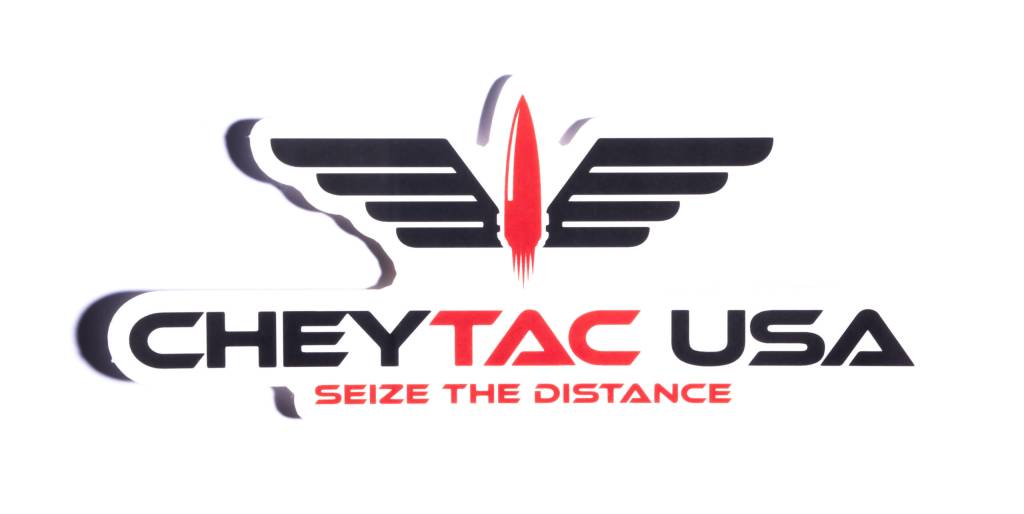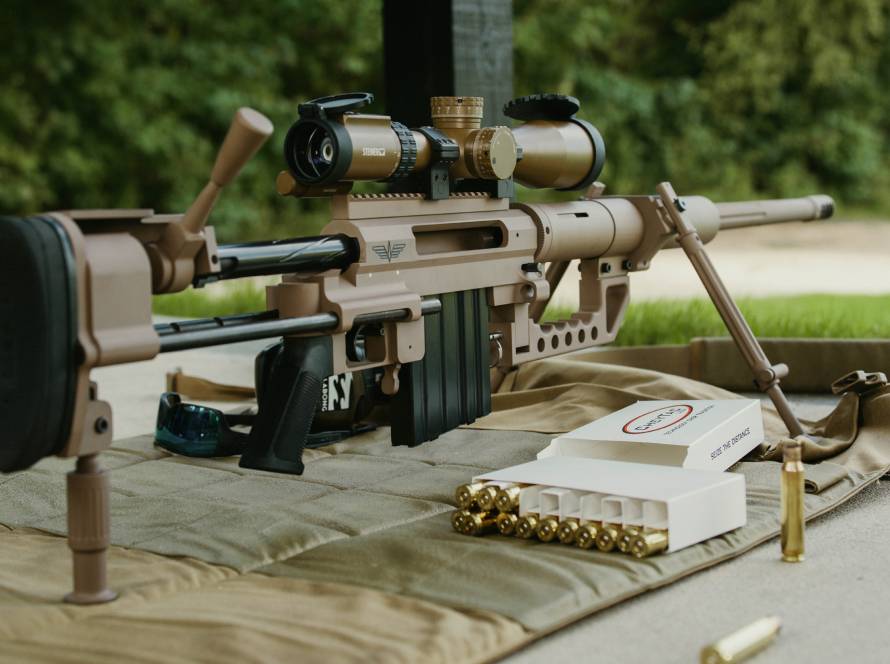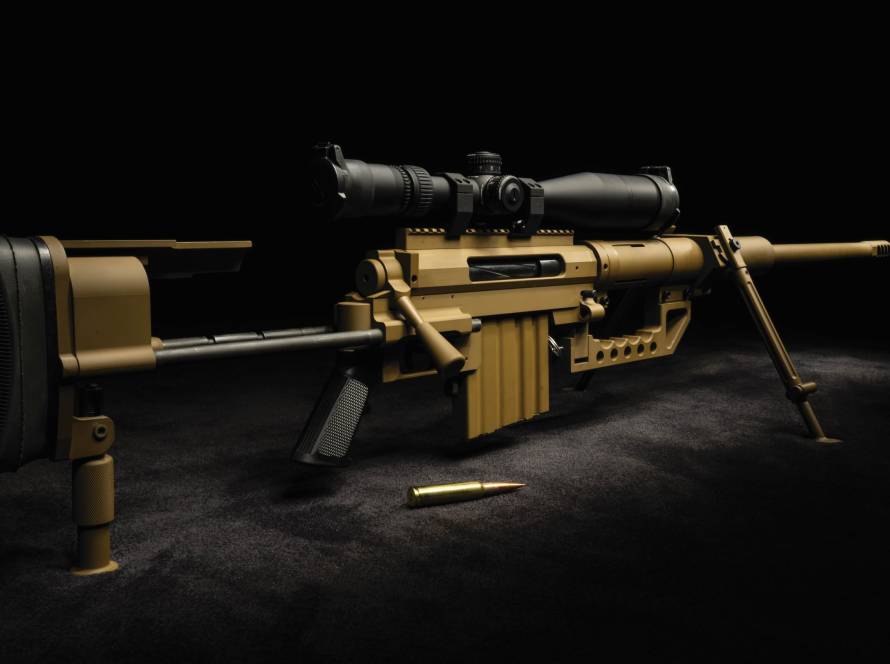When it comes to long-range precision targeting, few names carry the same weight as CheyTac. CheyTac’s proprietary cartridges and rifles exploded onto the international precision marksmanship scene in the early 2000s, utilizing modernized technology and manufacturing methods to challenge the dominance of ordnance and platforms that have been in use since the early 20th century.
But how did this innovative system come to be? The story begins with a problem that military and civilian marksmen alike had struggled with for years: how to deliver reliable, repeatable accuracy beyond 1,500 meters.
Origins and the .408 CheyTac Cartridge
Traditional cartridge sizes for rounds used in sniper roles are limited to .30 caliber (300 Winchester Magnum) and .50 caliber (50 caliber BMG). While both are effective in specific roles, both cartridges have significant drawbacks, largely due to the limitations of ballistic and manufacturing technologies available to their 20th-century developers.
The .300 Winchester Magnum, developed in 1968, is relatively lightweight and has low recoil, but its effective range is limited to 1,200 to 1,500 yards. The .50 BMG, initially introduced into service by the U.S. military in 1921, offers a significant upgrade in both power and range and is considered effective at 2,500 yards and beyond. The round’s extreme recoil requires extensive training to withstand, and the weight of both the projectile and the rifle necessitates thorough preparation and setup for practical use.
While both cartridges have proven themselves over decades of use, the challenge of achieving .50 BMG performance in a .30-caliber package has perplexed contractors for decades. As the 21st century dawned, advances in fields such as ballistics, metallurgy, and computing showed promise in closing the gap.
CheyTac set out to bridge this gap with a purpose-built cartridge. Drawing from the historic .505 Gibbs case, Dr. John D. Taylor and William O. Wordman reworked its metallurgy and internal design to handle modern pressures and deliver consistent performance at long distances. The result was the .408 CheyTac, a high-velocity, high-ballistic-coefficient round that could reliably break the 1,500-yard barrier while remaining relatively low in weight and recoil.
Proving Ground Breakthroughs (2001–2002)
Validation came early in the 2000s at the U.S. Army Proving Grounds in Yuma, Arizona. There, the .408 CheyTac’s projectile underwent a gauntlet of tests, with Weibel Doppler radar systems measuring the trajectory paths.
Unlike any projectile tested before, the .408 showed a clean, stable flight trace across the entire trajectory, including the critical transonic range where most bullets destabilize. The stability that the balanced flight .408 bullet displayed made the Yuma Radar techs sit up in their seats and immediately ask what had just been fired. They had never seen a bullet go transonic and maintain its stability like that before. This breakthrough was made possible by Jensen’s “balanced flight” design, which aligned linear and rotational drag to preserve gyroscopic stability over distances up to and beyond 2,500 meters.

Rifle System Development and Integration
With a revolutionary cartridge in hand, all that was left to do was design and build a delivery platform that could put it to good use. To maximize both precision and utility, this platform would need to be designed as a 7-shot repeating takedown rifle, with replaceable barrels suitable for a multitude of applications, a fully adjustable and collapsible buttstock, all while maintaining repeatably accurate performance.
The result of these efforts was the M-200 INTERVENTION rifle. The rifle’s ultra-modern ergonomic design and reputation for precision have made it a popular weapon of choice for characters across all types of media, including the movie Shooter and video games Call of Duty and Battlefield.
Precision barrels from Lawton Machine ensured sub-MOA performance at extreme range while exhibiting impressive durability, with one early prototype maintaining accuracy despite over 8,000 rounds being sent through it. The rifle’s adjustable stocks, integrated muzzle brakes, and scope rails with built-in elevation made field use practical and comfortable. The unique takedown design was incorporated to give a special operations sniper team the ability to jump with the rifle and insert via HALO & HAHO jumps.
The platform presents significant advantages over a traditional .50 BMG setup. Despite having a similar range, the INTERVENTION weighs 50% less than a typical rifle designed to fire .50-caliber rounds, and recoil is significantly reduced, leading to more accurate shots being put downrange.
Recognizing the military’s needs in the field, the M-400 semi-automatic variant was introduced to meet tactical requirements for faster follow-up shots. A third model, the M-310 single-shot rifle, was developed for benchrest shooters and law enforcement agencies.
Technology Takes Us (And Our Bullets) Farther
By the mid-2000s, CheyTac’s team had recognized the power of the weapon system they had created and set to work creating further technological integration (including its handheld Advanced Ballistic Computer (ABC)) to allow users to unlock its full potential.
The CheyTac ABC modeling is based on the extensive ballistics data provided by tests in the Yuma Proving Ground. During these tests, the CheyTac team collected a dizzying amount of ballistics data for every type of round currently in use by NATO militaries, from CheyTac’s own .408 caliber round to 5.56 NATO and .50 BMG.
The raw data was extensive, with a single round generating roughly 60 pages of raw data. Trajectory paths, the projectile’s velocity, and the drag coefficient at every meter from the muzzle to 3500 meters were all extensively measured, allowing the ABC system to accurately model ballistic paths once additional inputs like wind speed are entered.
To demonstrate the power of this technology, a NATO trial team used a rifle zeroed in Idaho to land a first-round hit on a steel target over 1,450 meters away in an unfamiliar mountain valley halfway across the globe. That level of performance quickly converted skeptics into customers. To date, CheyTac has trained elite military units and law enforcement agencies, with a strong track record of adoption by those who’ve tested the system in person.
Redefining the Standard
In CheyTac’s mission to build a cartridge that could build on the advantages of existing long range rounds, they managed to build an entire precision tactical shooting system. By combining cutting-edge ballistics data, a proprietary long-range round, and a modular precision rifle platform, the company permanently shifted the benchmarks for extreme-range shooting.
Since the INTERVENTION system’s inception, the weapon has been adopted by elite special forces and law enforcement all over the globe, including Poland’s famous GROM unit. The CheyTac team isn’t content to rest on its laurels, however, and the company continues to push the envelope on bleeding edge weapons and ordnance development. Follow us here to get updates on what’s next for the INTERVENTION and the CheyTac family!






8 Comments
Kimberly Lehner
Somebody essentially help to make significantly articles Id state This is the first time I frequented your web page and up to now I surprised with the research you made to make this actual post incredible Fantastic job
Lina Gutierrez
This topic is so relevant right now. Thanks for the timely post.
Taniya Nicholson
Great job! The conclusion tied everything together nicely.
Gideon Kidd
Practical advice that’s easy to implement. Much appreciated.
marketing service
I must say this article is extremely well written, insightful, and packed with valuable knowledge that shows the author’s deep expertise on the subject, and I truly appreciate the time and effort that has gone into creating such high-quality content because it is not only helpful but also inspiring for readers like me who are always looking for trustworthy resources online. Keep up the good work and write more. i am a follower.
zoritoler imol
I really appreciate this post. I have been looking everywhere for this! Thank goodness I found it on Bing. You’ve made my day! Thank you again
Jude
Pretty nice post. I just stumbled upon your weblog and
wished to say that I have truly enjoyed surfing around your
Ƅlog posts. Aftеr all I’ⅼl be sᥙbscribing to your fed and I hope youu write agаin soοn!
My blog; Rafa88
tlover tonet
Thank you for the sensible critique. Me and my neighbor were just preparing to do a little research on this. We got a grab a book from our local library but I think I learned more from this post. I’m very glad to see such excellent information being shared freely out there.